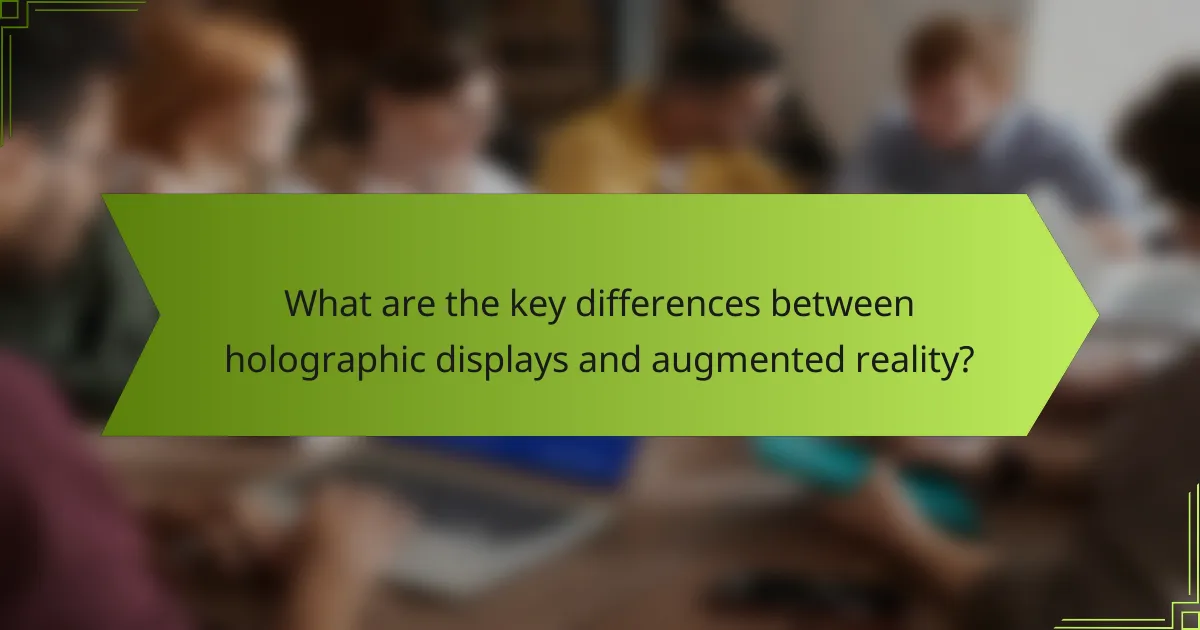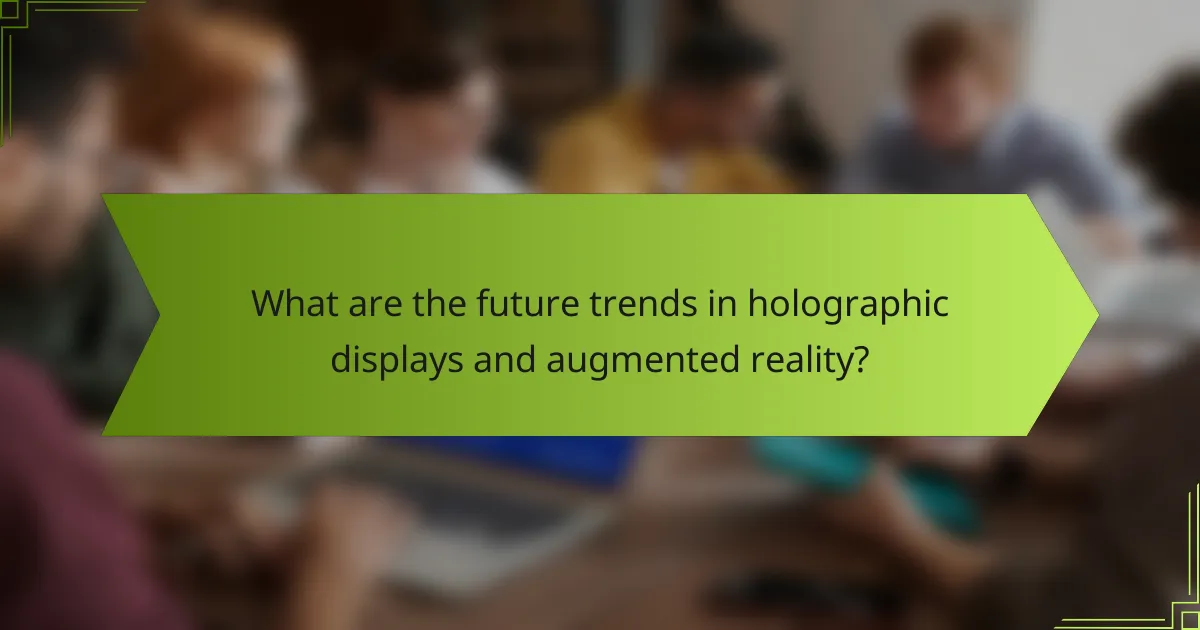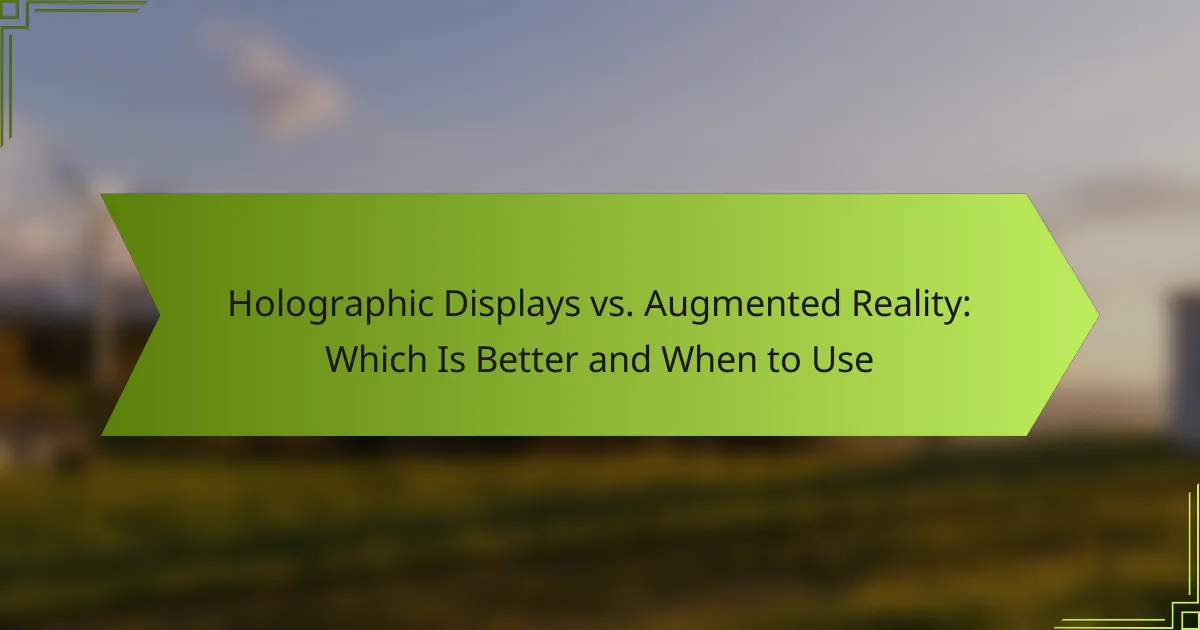Holographic displays and augmented reality (AR) offer unique advantages depending on the context of their use. Holographic displays excel in providing three-dimensional visualizations that enhance understanding of complex concepts, while AR enriches real-world experiences by overlaying digital content, making it ideal for interactive applications in marketing and retail.

What are the key differences between holographic displays and augmented reality?
Holographic displays and augmented reality (AR) serve different purposes and operate on distinct principles. Holographic displays create three-dimensional images that can be viewed from various angles, while augmented reality overlays digital content onto the real world, enhancing the user’s perception of their environment.
Holographic displays create three-dimensional images
Holographic displays utilize light interference to project three-dimensional images that appear to float in space. This technology allows viewers to see different perspectives of the image as they move around it, providing a more immersive experience. Common applications include medical imaging, product design, and entertainment.
These displays often require specialized equipment, such as holographic projectors or screens, which can be expensive and complex to set up. However, the visual impact can be significant, making them suitable for scenarios where depth perception is crucial.
Augmented reality overlays digital content on the real world
Augmented reality enhances the real-world environment by superimposing digital information, such as images or text, onto it. This is typically achieved through smartphones, tablets, or AR glasses, allowing users to interact with both physical and digital elements simultaneously. Popular examples include mobile games like Pokémon GO and AR navigation apps.
AR is generally more accessible than holographic displays, as it can be used with devices most people already own. This widespread availability makes AR a versatile option for various applications, from education to retail.
Use cases vary significantly between the two technologies
The use cases for holographic displays and augmented reality differ greatly due to their unique capabilities. Holographic displays are often employed in fields requiring detailed visualization, such as architecture, engineering, and medical training. They excel in scenarios where depth and spatial awareness are vital.
In contrast, augmented reality is widely used in consumer applications, such as gaming, advertising, and interactive learning. Its ability to blend digital content with the real world makes it ideal for enhancing user engagement and providing contextual information.
Hardware requirements differ for each technology
Holographic displays typically require advanced hardware, including specialized projectors and screens, which can be costly and may necessitate a dedicated setup space. This can limit their accessibility for casual users or small businesses.
On the other hand, augmented reality can often be experienced on standard smartphones or tablets, making it more user-friendly and affordable. Some AR applications may require additional accessories, such as AR glasses, but these are generally less expensive than full holographic systems.
Interaction methods vary between holographic displays and augmented reality
Interaction with holographic displays often involves gesture recognition or specialized controllers, allowing users to manipulate the 3D images in real-time. This can create a more engaging experience, but it may require users to learn new interaction techniques.
In contrast, augmented reality typically utilizes touchscreens or voice commands for interaction, making it intuitive for most users. This ease of use can lead to quicker adoption and integration into everyday activities, such as shopping or navigation.

When should I use holographic displays?
Holographic displays are best utilized in scenarios where a three-dimensional representation enhances understanding and engagement. They are particularly effective in settings that require detailed visualization and interaction with complex data or concepts.
Best for immersive presentations and exhibitions
Holographic displays excel in creating captivating presentations and exhibitions. They allow audiences to experience content in a more engaging manner, making it easier to grasp intricate ideas. For instance, product launches can benefit from holographic displays that showcase items in 3D, drawing attention and enhancing memorability.
When planning an exhibition, consider the space and audience interaction. Ensure the display is positioned for optimal visibility and engagement, as well as considering the technical requirements for setup.
Ideal for training simulations in specialized fields
In specialized fields like medicine or aviation, holographic displays provide realistic training simulations. They allow trainees to interact with lifelike scenarios, improving retention and understanding of complex procedures. For example, medical students can practice surgeries using holographic models, gaining hands-on experience without risks.
When implementing holographic training, focus on the fidelity of the simulations and the interactivity offered. Ensure that the technology aligns with the training objectives and is accessible to all participants.
Effective for design visualization in architecture
Holographic displays are highly effective for architectural design visualization. They enable architects and clients to view projects in three dimensions, facilitating better communication of ideas and design intentions. This can lead to more informed decision-making and fewer revisions during the design process.
When using holographic displays in architecture, consider integrating them into client meetings to showcase designs interactively. This approach can help clarify spatial relationships and material choices, ultimately enhancing client satisfaction.

When should I use augmented reality?
Augmented reality (AR) is best utilized when you want to enhance real-world experiences with digital elements. It is particularly effective in scenarios where interactivity and user engagement are key, such as mobile applications, marketing, and retail environments.
Suitable for mobile applications and gaming
Augmented reality shines in mobile applications and gaming, allowing users to interact with digital objects in their real-world surroundings. Popular games like Pokémon GO demonstrate how AR can create engaging experiences by overlaying virtual characters onto physical locations.
When developing AR mobile apps, consider the device’s camera quality and processing power, as these factors significantly impact performance. Aim for low latency to ensure smooth interactions, ideally under 50 milliseconds, to maintain user immersion.
Effective for interactive marketing campaigns
AR is a powerful tool for interactive marketing campaigns, enabling brands to create memorable experiences that captivate consumers. By allowing potential customers to visualize products in their own environment, companies can enhance engagement and drive sales.
For instance, furniture retailers can use AR to let customers see how a piece of furniture would look in their home before making a purchase. This approach not only boosts customer confidence but can also reduce return rates.
Useful in retail for virtual try-ons
In retail, augmented reality facilitates virtual try-ons, allowing customers to see how clothing, accessories, or cosmetics will look on them without physically trying them on. This technology can significantly enhance the shopping experience and reduce the friction often associated with online purchases.
Brands like Warby Parker and Sephora have successfully implemented AR for virtual try-ons, leading to increased customer satisfaction and conversion rates. When integrating this feature, ensure the AR application is user-friendly and accurately reflects the product’s appearance to build trust with consumers.

What are the cost considerations for holographic displays and augmented reality?
Cost considerations for holographic displays and augmented reality (AR) vary significantly based on technology, application, and deployment scale. Holographic displays typically involve higher initial investments, while AR solutions can be more budget-friendly, especially for mobile applications.
Holographic displays often require higher initial investment
Holographic displays generally necessitate advanced hardware and software, leading to higher upfront costs. These systems often include specialized projectors, screens, and computing power, which can range from several thousand to tens of thousands of dollars.
Additionally, the installation and setup of holographic systems may require professional services, further increasing initial expenses. Businesses should weigh these costs against the potential benefits, such as enhanced user engagement and unique visual experiences.
Augmented reality can be more cost-effective for mobile solutions
Augmented reality often leverages existing mobile devices, making it a more economical choice for many applications. With smartphones and tablets already equipped with AR capabilities, businesses can implement AR solutions with minimal additional investment.
Costs for AR development can vary, but many platforms offer affordable development tools and frameworks. This accessibility allows companies to create AR experiences without the need for extensive hardware upgrades.
Maintenance costs differ significantly
Maintenance costs for holographic displays can be substantial due to the complexity of the technology. Regular servicing, software updates, and potential hardware replacements can add to ongoing expenses, making budgeting essential.
In contrast, AR solutions typically incur lower maintenance costs, as they rely on widely used mobile devices. Updates and maintenance can often be managed remotely, reducing the need for on-site technical support.

What are the future trends in holographic displays and augmented reality?
Future trends in holographic displays and augmented reality (AR) indicate significant advancements in both fields, driven by technological innovations and increased industry adoption. As hardware improves and integration with artificial intelligence becomes more prevalent, these technologies are set to transform user experiences across various sectors.
Advancements in hardware technology
Recent developments in hardware technology are crucial for enhancing the capabilities of holographic displays and AR systems. Innovations such as lighter, more efficient projectors and improved display materials are making holograms more accessible and realistic. For AR, advancements in mobile processors and graphics chips are enabling smoother experiences and more complex overlays in real-time.
Companies are also focusing on miniaturization, allowing devices to become more portable without sacrificing performance. This trend is particularly evident in the development of AR glasses, which are becoming lighter and more user-friendly, paving the way for everyday use.
Integration with artificial intelligence
The integration of artificial intelligence (AI) into holographic displays and AR is enhancing interactivity and personalization. AI algorithms can analyze user behavior and preferences, allowing for tailored experiences that adapt in real-time. This capability is particularly beneficial in training simulations and educational environments, where user engagement is critical.
Moreover, AI can improve object recognition and tracking in AR applications, making overlays more accurate and responsive. This leads to more immersive experiences, especially in sectors such as retail, where virtual try-ons can be enhanced through AI-driven suggestions.
Increased adoption in various industries
Holographic displays and AR are seeing increased adoption across multiple industries, including healthcare, education, and entertainment. In healthcare, for instance, AR is being used for surgical planning and training, allowing medical professionals to visualize complex procedures in a 3D space. Similarly, in education, these technologies are facilitating interactive learning experiences that engage students more effectively.
The entertainment industry is also leveraging these advancements, with AR games and holographic concerts gaining popularity. As these technologies become more mainstream, businesses are recognizing their potential to enhance customer engagement and operational efficiency.
Emerging applications in remote collaboration
Remote collaboration is one of the most promising applications for holographic displays and AR. These technologies enable teams to work together in virtual environments, regardless of their physical locations. For example, architects can use AR to visualize building designs on-site, allowing for real-time modifications and discussions.
Additionally, holographic displays can facilitate immersive meetings where participants feel as if they are in the same room, enhancing communication and reducing the feeling of isolation often associated with remote work. As companies continue to adapt to hybrid work models, the demand for effective remote collaboration tools will likely grow, driving further innovation in this area.
